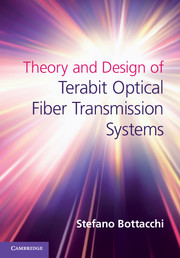Book contents
- Frontmatter
- Dedication
- Contents
- Preface
- Acknowledgments
- Part I Signals, spectra and optical modulations
- Part II Principles of light polarization and optical amplification
- 4 Principles of non-linear optics and light polarization
- 5 Principles of light amplification
- 6 Spectral gain modeling of optical amplifiers
- 7 Noise theory of optical amplifiers
- Part III Interferometric optical modulators
- Part IV
- Appendix A Electromagnetic energy and power flow
- Appendix B Optical power and photon flux
- Index
- References
7 - Noise theory of optical amplifiers
Optical beat-noise components of the photocurrent equivalent
from Part II - Principles of light polarization and optical amplification
Published online by Cambridge University Press: 05 September 2014
- Frontmatter
- Dedication
- Contents
- Preface
- Acknowledgments
- Part I Signals, spectra and optical modulations
- Part II Principles of light polarization and optical amplification
- 4 Principles of non-linear optics and light polarization
- 5 Principles of light amplification
- 6 Spectral gain modeling of optical amplifiers
- 7 Noise theory of optical amplifiers
- Part III Interferometric optical modulators
- Part IV
- Appendix A Electromagnetic energy and power flow
- Appendix B Optical power and photon flux
- Index
- References
Summary
Introduction
This chapter presents the semiclassical theory of beat noise generated by amplified spontaneous emission (ASE) noise during the photodetection process. Beat noise theory was proposed by N. A. Olsson [1] in 1989, when the erbium-doped fiber amplifier (EDFA) begun the first revolution in optical communications, enabling an increase of more than two orders of magnitude in transmission capacity using the dense wavelength division multiplexing (DWDM) technique. Intensity modulation (IM) and direct detection (DD) transmission systems deploying DWDM with EDFA and chromatic dispersion compensation mapping largely dominated optical transmission engineering for more than a decade, up to early 2000. More than 400 optical channels running at 10 Gb/s were tightly packed together in an ITU-T standard 25 GHz optical grid, providing an incredibly powerful transmission capacity of 4 Tb/s over several thousands of kilometers of a single-mode optical fiber. In order to support such huge optical channel multiplexing, the optical link had to be compensated for uniform transmission characteristics over at least 80 nm, approximately between 1530 nm and 1610 nm, involving what is known as the C+L bands of the optical fiber transmission windows. Moreover, to compensate for the large optical attenuation and chromatic dispersion encountered along such a link length, optical regeneration stations were used about every 80 km. In a typical 2 000 km link length about 25 optical regeneration stations, each consisting of a pair of C+L flatband optical amplifiers and a bundle of dispersion compensating fibers (DCF), were needed. Since an optical link is intended to be bi-directional, it is apparent that the number of regeneration stations must be doubled to include both senses of transmission, leading to about 100 EDFA for a 2000 km single-fiber link operating at 4 Tb/s over 400 wavelengths in a 25 GHz grid. The second revolution in Optical communications came few years ago, with the advent of coherent optical communication. Today, optical coherent detection (CD) using intradyne and polarization diversity techniques has definitely replaced the heavy, hardware-based IM-DD optical network design with a flexible optical grid allocation, allowing up to 448 Gb/s transmission using a dual-polarization 16QAM modulation format over two optical subcarriers. Of course, DWDM technology is still available and is indeed used to increase network capacity almost proportionally to the number of optical wavelengths.
- Type
- Chapter
- Information
- Theory and Design of Terabit Optical Fiber Transmission Systems , pp. 433 - 584Publisher: Cambridge University PressPrint publication year: 2014



